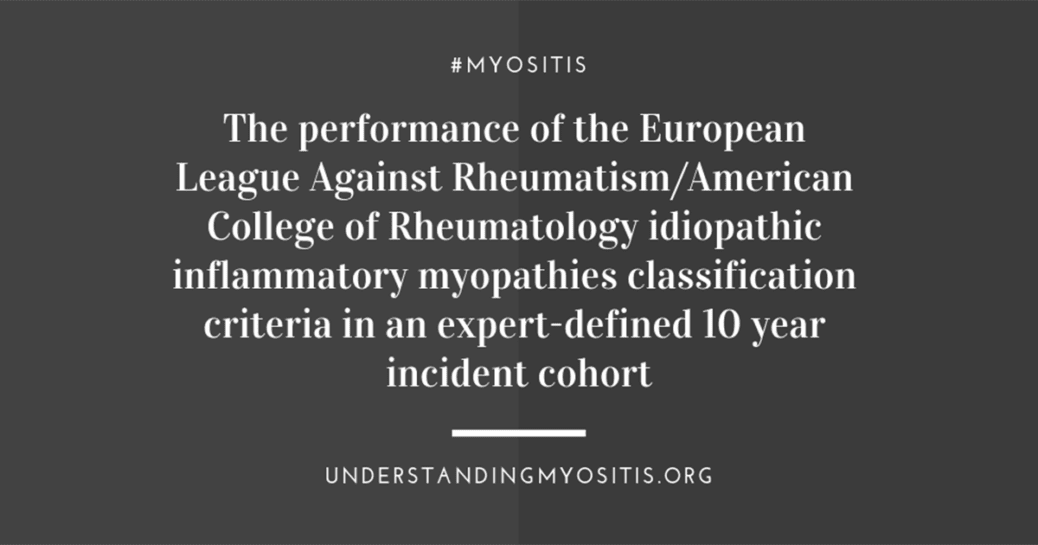Introduction
In a paper published on October 30, 2017, the European League Against Rheumatism/American College of Rheumatology (EULAR/ACR) proposed new classification criteria for adult and juvenile idiopathic inflammatory myopathies (IIM) and their major subgroups. Myositis Support and Understanding (MSU) posted a summary of that article on November 5, 2018, which can be found here: https://understandingmyositis.org/eular-acr-classification-criteria-adult-juvenile-iim/. This paper assesses the performance of EULAR/ACR classification criteria in a cohort of IIM cases and examines how subtypes of IIM identified by the criteria compares to expert opinion.
In 1975, the first widely accepted classification criteria for IIMs were published, but because IIMs can be so different in areas of the body affected, severity, disease pattern, and response to treatment it remains difficult to accurately classify disease and subtype. Many advancements have improved understanding of various aspects of IIM and this improved understanding has been readily applied in clinical practice. However, for research purposes, the advancements have not been so easily translated into diagnostic and classification criteria needed to identify and categorize patients for studies to ensure accurate and relevant results.
The EULAR/ACR classification criteria includes 16 variables that are scored and used to determine a diagnosis of IIM and distinct subtypes of polymyositis (PM), dermatomyositis (DM), amyopathic DM (ADM) or inclusion body myositis (IBM). However, there were a number of issues related to the development of the criteria, which were acknowledged by the authors. For example, limited antibody testing was available so only the anti-Jo-1 antibody was included in the criteria. Also, additional subtypes, now well-established, were not included, specifically: anti-synthetase syndrome (ASS), immune-mediated necrotizing myopathy (IMNM), and overlap myositis (OM).
Methodology
The researchers retrospectively reviewed relevant data in cases of adults (18+ years old at time of disease onset) with newly diagnosed IIM at the Salford Royal National Health Service (NHS) Foundation Trust (UK) over a 10-year period, between January 1, 2007 and December 31, 2016, and included those that met a diagnosis of IIM based on a consensus of expert opinions. The experts then classified each case a single subtype of PM, DM, ASS, IMNM, ADM, IBM or OM. Then, the EULAR/ACR classification criteria were applied to diagnose IIM and subtypes.
Results
Of the 1637 cases that were initially screened, 255 were ultimately identified and classified using consensus expert opinion. Of the 255 cases, 157 (61.6%) were women and the mean age at diagnosis was 55.3 years. The expert consensus subtype classification resulted in the following:
| Expert Assigned IIM Subtype | Frequency | Percentage |
| PM | 37 | 14.5% |
| DM | 57 | 23.4% |
| IBM | 56 | 22% |
| ADM | 14 | 5.5% |
| ASS | 34 | 13.3% |
| IMNM | 25 | 9.8% |
| OM | 32 | 12.5% |
All of the 255 cases had test results for antibodies with 112 (43.9%) negative for antibodies. Of the remaining 143 cases, 117 (81.8%) had a single antibody detected. No case had more than two antibodies.
Classification using the EULAR/ACR criteria, for probable IIM and definite IIM cut-point scores combined, accurately diagnosed 254 of the 255 cases (99.6%) as compared to the expert consensus. However, when using only the definite IIM cut-point score, only 206 of the 255 cases were accurately diagnosed (80.9%). Interestingly, the 49 cases mis-diagnosed included many cases of IMNM and OM, however, if biopsy data were not included in the scoring criteria, the accuracy for definite IIM would have increased to 90.2%. Generally, more data is better, but in the case of muscle biopsies, there are several things that could complicate diagnosis. For example, absolutely identifying the presence or absence of certain features can be challenging, deciding what biopsy criteria to use is subjective, and the time and place of the biopsy sampling is significant.
Because the EULAR/ACR classification criteria include only four IIM subtypes, a comparison with the expert consensus results was done for those four subtypes. For PM, IBM and ADM, the EULAR/ACR criteria and the expert opinions were 100% in agreement. For DM, the EULAR/ACR criteria categorized 3 of 57 cases as PM instead of DM, a 94.7% accuracy score. Overall, only 3 of 255 cases were in disagreement for the four subtypes, for a 98.2% accuracy score.
Overall, in 36.9% of the cases there was disagreement between the EULAR/ACR criteria and expert consensus. One of the biggest areas of discrepancy between the two classification methods was that 87 of 124 cases (70.2%) that were classified as PM by the EULAR/ACR system were classified as something else by the expert consensus. Overdiagnosis of PM has been an ongoing concern about all IIM classification criteria. The EULAR/ACR criteria classified 124 cases as PM (48.6%), whereas the expert consensus only classified 37 as PM (14.5%).
Conclusion
The EULAR/ACR criteria were highly accurate in identifying cases of IIM. This is remarkable considering that in this study the criteria were applied at diagnosis rather than later when the disease has become established and fully manifested. The EULAR/ACR criteria were developed in patients with more established IIM diseases. But there were significant differences between consensus expert opinion and the EULAR/ACR criteria for IIM subtype classification, particularly for PM. These differences may be important when applying the EULAR/ACR criteria in the future. Additional research is needed to resolve the differences.
Citation:
Matthew J S Parker, Alexander Oldroyd, Mark E Roberts, James B Lilleker, Zoe E Betteridge, Neil J McHugh, Ariane L Herrick, Robert G Cooper, Hector Chinoy; The performance of the European League Against Rheumatism/American College of Rheumatology idiopathic inflammatory myopathies classification criteria in an expert-defined 10 year incident cohort, Rheumatology, , key343, https://doi.org/10.1093/rheumatology/key343
Tags: myositis research









